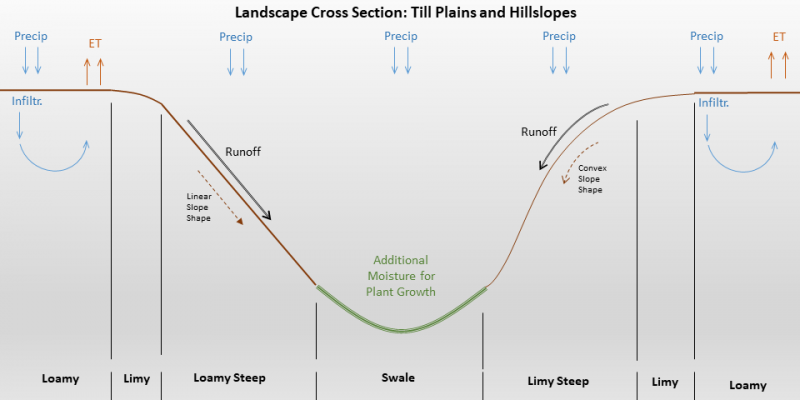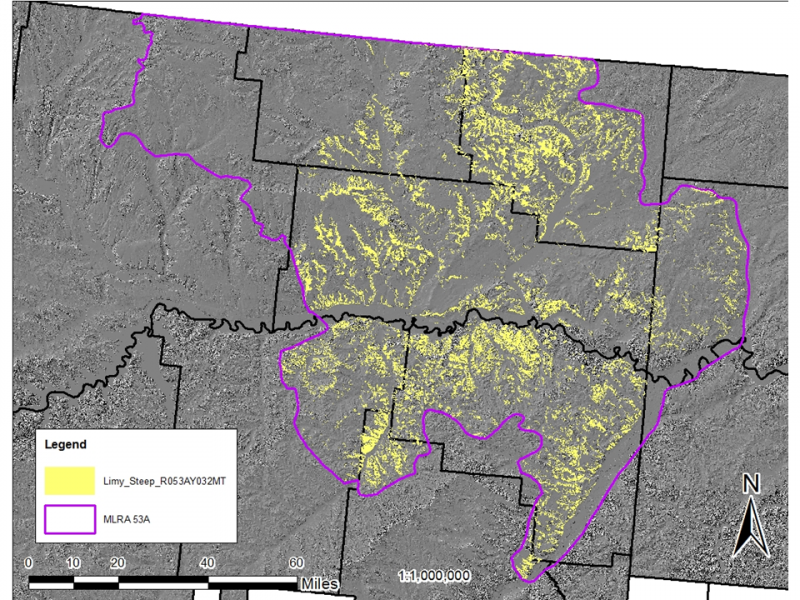
Natural Resources
Conservation Service
Ecological site FX053A99X029
Limy Steep (LyStp)
Last updated: 4/22/2025
Accessed: 12/21/2025
General information
Provisional. A provisional ecological site description has undergone quality control and quality assurance review. It contains a working state and transition model and enough information to identify the ecological site.
MLRA notes
Major Land Resource Area (MLRA): 053A–Northern Dark Brown Glaciated Plains
The Northern Dark Brown Glaciated Plains, MLRA 53A, is a large, agriculturally and ecologically significant area. It consists of approximately 6.1 million acres and stretches 140 miles from east to west and 120 miles from north to south, encompassing portions of 8 counties in northeastern Montana and northwestern North Dakota. This region represents part of the southern edge of the Laurentide Ice Sheet during maximum glaciation. It is one of the driest and westernmost areas within the vast network of glacially derived prairie pothole landforms of the Northern Great Plains and falls roughly between the Missouri Coteau to the east and the Brown Glaciated Plains to the west. Elevation ranges from 1,800 feet (550 meters) to 3,300 feet (1,005 meters).
Soils are primarily Mollisols, but Inceptisols and Entisols are also common. Till from continental glaciation is the predominant parent material, but alluvium and bedrock are also common. Till deposits are typically less than 50 feet thick (Soller, 2001). Underlying the till is sedimentary bedrock largely consisting of Cretaceous shale, sandstone, and mudstone (Vuke et al., 2007). The bedrock is commonly exposed on hillslopes, particularly along drainageways. Significant alluvial deposits occur in glacial outwash channels and along major drainages, including portions of the Missouri, Poplar, and Big Muddy Rivers. Large eolian deposits of sand occur in the vicinity of the ancestral Missouri River channel east of Medicine Lake (Fullerton et al., 2004). The northwestern portion of the MLRA contains a large unglaciated area containing paleoterraces and large deposits of sand and gravel known as the Flaxville gravel.
Much of this MLRA was glaciated towards the end of the Wisconsin age, and the maximum glacial extent occurred approximately 20,000 years ago (Fullerton and Colton, 1986; Fullerton et al., 2004). Subsequent erosion from major stream and river systems has created numerous drainageways throughout much of the MLRA. The result is a geologically young landscape that is predominantly a dissected till plain interspersed with alluvial deposits and dominated by soils in the Mollisol and Inceptisol orders. Much of this area is typic ustic, making these soils very productive and generally well suited to production agriculture.
Dryland farming is the predominant land use, and approximately 50 percent of the land area is used for cultivated crops. Winter, spring, and durum varieties of wheat are the major crops, with over 48 million bushels produced annually (USDA-NASS, 2017). Areas of rangeland typically are on steep hillslopes along drainages. The rangeland is mostly native mixed-grass prairie similar the Stipa-Agropyron, Stipa-Bouteloua-Agropyron, and Stipa-Bouteloua faciations (Coupland, 1950; 1961). Cool-season grasses dominate and include rhizomatous wheatgrasses, needle and thread, western porcupine grass, and green needlegrass. Woody species are generally rare; however, many of the steeper drainages support stands of trees and shrubs such as green ash and chokecherry. Seasonally ponded, prairie pothole wetlands may occur throughout the MLRA, but the greatest concentrations are in the east and northeast where receding glaciers stagnated and formed disintegration moraines with hummocky topography and numerous areas of poorly drained soils.
Classification relationships
NRCS Soil Geography Hierarchy
• Land Resource Region: Northern Great Plains
• Major Land Resource Area (MLRA): 053A Northern Dark Brown Glaciated Plains
National Hierarchical Framework of Ecological Units (Cleland et al., 1997; McNab et al., 2007)
• Domain: Dry
• Division: Temperate Steppe
• Province: Great Plains-Palouse Dry Steppe Province 331
• Section: Glaciated Northern Grasslands Section 331L
• Subsection: Glaciated Northern Grasslands Subsection 331La
• Landtype association/Landtype phase: N/A
National Vegetation Classification Standard (Federal Geographic Data Committee, 2008)
• Class: Mesomorphic Shrub and Herb Vegetation Class (2)
• Subclass: Temperate and Boreal Grassland and Shrubland Subclass (2.B)
• Formation: Temperate Grassland and Shrubland Formation (2.B.2)
• Division: Central North American Grassland and Shrubland Division (2.B.2.Nb)
• Macrogroup: Hesperostipa comata - Pascopyrum smithii - Festuca hallii Grassland Macrogroup (2.B.2.Nb.2)
• Group: Pascopyrum smithii - Hesperostipa comata - Schizachyrium scoparium Mixedgrass Prairie Group (2.B.2.Nb.2.c)
• Alliance: Schizachyrium scoparium Northwestern Great Plains Grassland Alliance
• Association: Schizachyrium scoparium - Muhlenbergia cuspidata Grassland
EPA Ecoregions
• Level 1: Great Plains (9)
• Level 2: West-Central Semi-Arid Prairies (9.3)
• Level 3: Northwestern Glaciated Plains (42)
• Level 4: Glaciated Dark Brown Prairie (42i)
Glaciated Northern Grasslands (42j)
Ecological site concept
This provisional ecological site is common throughout MLRA 53A. Figure 2 illustrates the distribution of this ecological site based on current data. This map is approximate, is not intended to be definitive, and may be subject to change. Limy Steep is an extensive ecological site occurring on moderately steep to very steep landscapes, typically along the sides of drainages. This site is characterized by a relatively young, undeveloped soil profile, which is evidenced by increased calcium carbonate (lime) concentrations in the upper 5 inches. Soils typically have an ochric epipedon and are deeper than 20 inches to a restrictive layer. Characteristic vegetation is little bluestem (Schizachyrium scoparium), plains muhly (Muhlenbergia cuspidata), and needle and thread (Hesperostipa comata).
Associated sites
| FX053A99X032 |
Loamy (Lo) This site occurs on gentler slopes (less than 15 percent) upslope from the Limy Steep ecological site. It is most commonly on summits where slopes are linear or concave. It may also occur on footslopes. |
|---|---|
| FX053A99X062 |
Swale (Se) This site is generally downslope from the Limy Steep ecological site in swales and drainageways and receives additional moisture from surface water run-in. Soils are typically more than 40 inches deep, are pachic, and have a higher available water-holding capacity. |
| FX053A99X030 |
Limy (Ly) This site occurs on gentler slopes (less than 15 percent) upslope from the Limy Steep ecological site. It is generally on shoulders or crests whereas the Limy Steep ecological site is on backslopes. |
| FX053A99X040 |
Loamy Steep (LoStp) This site occurs on moderate to steeply sloping hillslopes adjacent to the Limy Steep ecological site. It occurs in backslope positions with slopes of 15 percent or greater and most commonly occurs on north-facing slopes or slopes with a linear or concave shape. |
Similar sites
| FX053A99X030 |
Limy (Ly) This site differs from the Limy Steep ecological site in that slopes are less than 15 percent. |
|---|---|
| FX053A99X040 |
Loamy Steep (LoStp) This site differs from the Limy Steep ecological site in that the soils contain less than 5 percent calcium carbonate in the upper 5 inches (as evidenced by lack of effervescence). |

Figure 1. Diagram of similar and associated sites.
Table 1. Dominant plant species
| Tree |
Not specified |
|---|---|
| Shrub |
Not specified |
| Herbaceous |
(1) Schizachyrium scoparium |
Legacy ID
R053AY705MT
Click on box and path labels to scroll to the respective text.
Ecosystem states
| T1A | - | Introduction of non-native grass species, such as Kentucky bluegrass, smooth brome, and crested wheatgrass. |
|---|---|---|
| T2A | - | Prolonged drought, improper grazing management, or a combination of these factors |
| T2B | - | Displacement of native species by non-native invasive species (Crested Wheatgrass, Kentucky bluegrass, noxious weeds, etc.) |
| R3A | - | Range seeding, grazing land mechanical treatment, timely moisture, proper grazing management (management intensive and costly) |
State 1 submodel, plant communities
State 2 submodel, plant communities
| 2.1A | - | Drought, improper grazing management |
|---|---|---|
| 2.2A | - | Return to normal or above average precipitation, proper grazing management |
